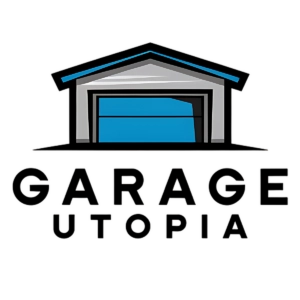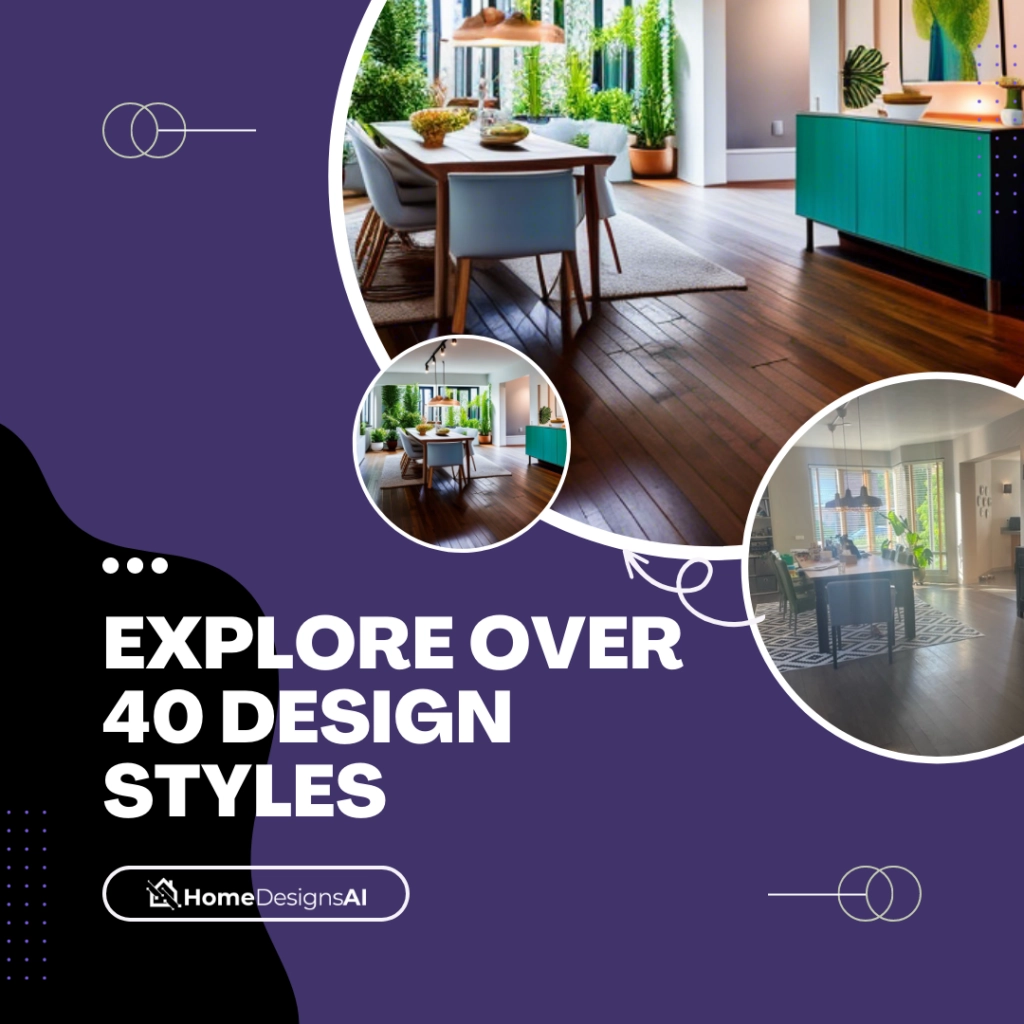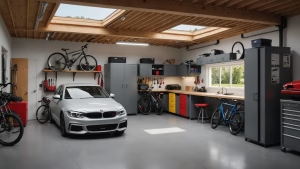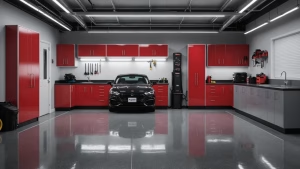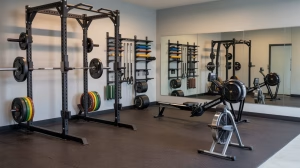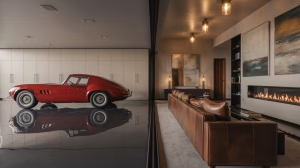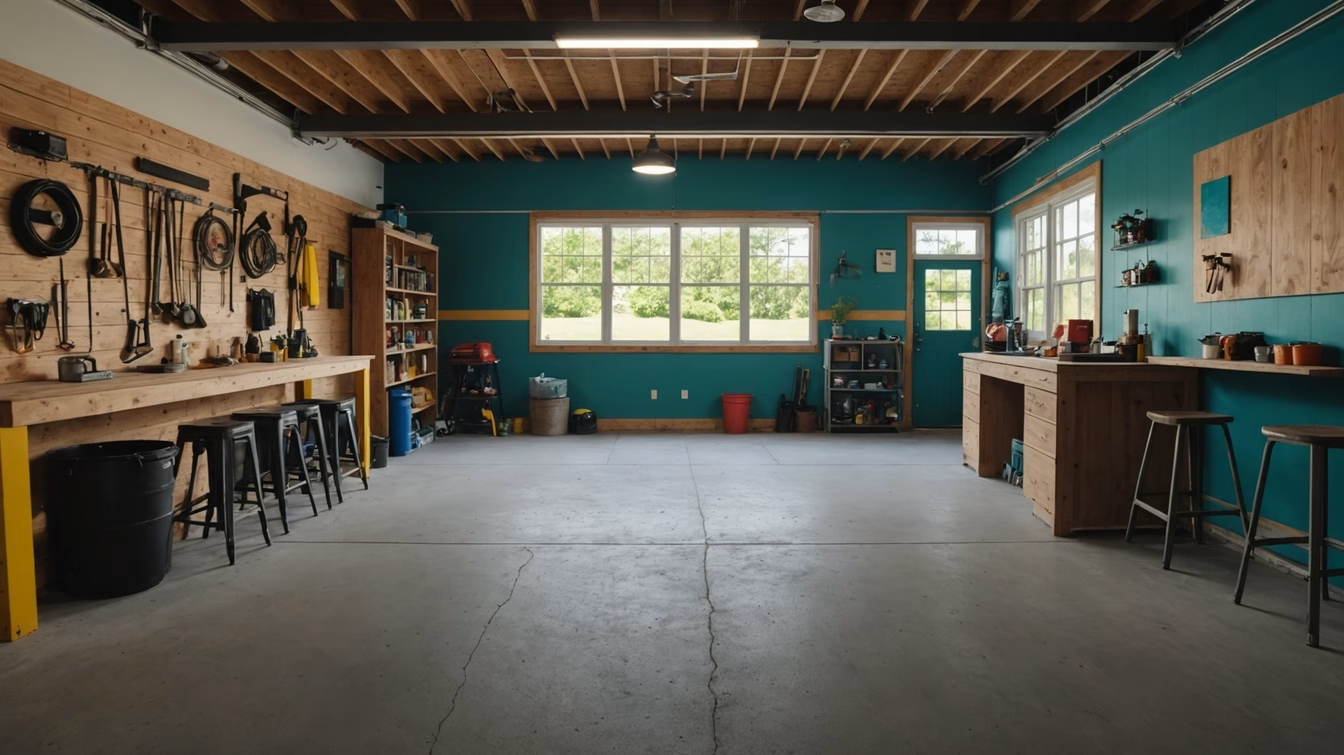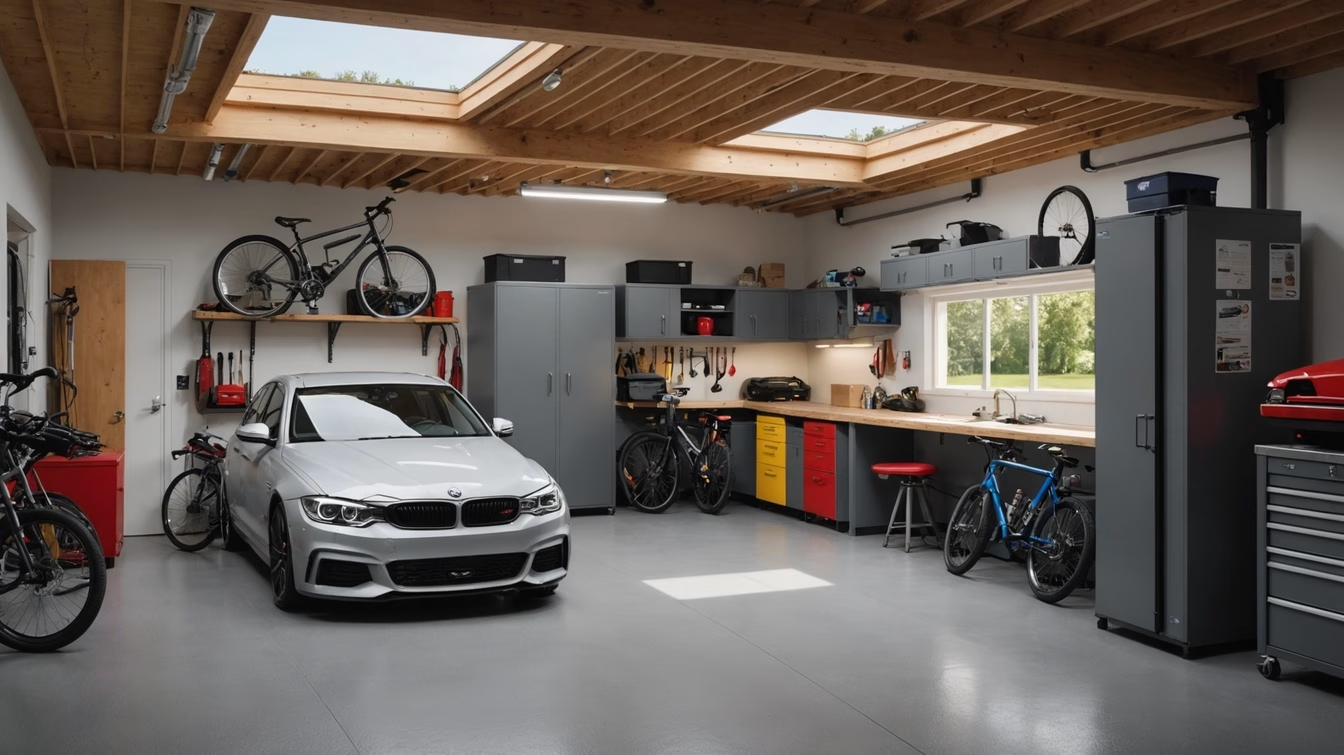Garage design ideas often begin with the fundamentals. However, the right garage floor and wall color combinations can turn this underutilized space into a functional yet stylish area. The color choices for walls and floors significantly impact lighting, cleanliness, and how well the space integrates with your home’s exterior. Options like white garage doors and neutral wall tones, such as gray or beige, strike a balance between aesthetics and practicality. Materials like epoxy or semigloss paint ensure the space remains durable.
When selecting shades, understanding the materials is crucial. Semigloss paint on walls resists scuffs, and epoxy floors hide tire marks better than latex. Lighter grays can brighten spaces but show dirt easily. On the other hand, darker hues like Sherwin-Williams’ Agreeable Gray (SW 7029) offer durability. This guide delves into how color selections can enhance your garage’s look, from matching exterior colors like Somerset white to adding personality with muted greens or reds. Discover how small design changes can create a cohesive, low-maintenance space that reflects your style.
Why Your Garage Interior Design Matters

Today’s garages are more than just car storage; they serve as spaces for hobbies, workouts, or storage solutions. Garage design ideas transform these areas into functional hubs that enhance daily life. A well-planned garage makeover can boost home value and create a welcoming entryway.
Functionality is key in modern garage design. Organized storage systems and durable materials improve usability. Homes with updated garages sell faster, according to real estate data. Light wall colors reflect light, cutting energy costs, while smart color choices reduce clutter’s visual impact.
Color plays a significant role. Light tones like white or gray keep spaces bright and hide dirt, saving on lighting bills. Darker shades may absorb heat but work well for accents. Semi-gloss paint resists stains, making cleaning easier. Proper materials, like mold-resistant options, ensure longevity.
Modern garage makeover inspiration often includes checkerboard floors or epoxy coatings to hide wear. Smart paint choices, like primer and quality finishes, protect against moisture and stains. Prioritizing design ideas like these creates a space that’s both practical and visually appealing.
Well-designed garages also enhance curb appeal. A clean, organized garage signals care for the home. These spaces set the tone for how buyers perceive the entire property, making garage design ideas a smart investment in both utility and resale potential.
Understanding Color Theory for Garage Spaces
Color theory is key to a unified garage design. First, determine your garage’s purpose. Workshops benefit from soothing blues or greens, while gyms need energizing reds or oranges. Neutral shades like grays or whites serve as versatile backdrops, enhancing tools or vehicles.
Start with a color wheel to find harmonious pairs. Complementary colors, opposite each other, create striking contrasts. Analogous hues, next to each other, offer smooth transitions.
Matching walls and floors involves considering undertones. Wooden floors with warm undertones complement earthy wall tones. Cool undertones pair well with lighter, brighter walls. Lighter colors make small spaces appear larger. Darker hues, like charcoal or slate, hide stains but need brighter lighting.
Epoxy coatings in flake or metallic finishes add visual appeal without overwhelming the space.
Semigloss paint on walls resists scuffs and grease, while epoxy floors offer durability and style. Cool tones like blue or green promote focus, perfect for workshops. Warm tones energize fitness zones.
Pair glossy finishes with lighter walls for maximum brightness. Matte surfaces create a minimalist look. Balancing warm and cool tones ensures both functionality and aesthetic harmony.
Popular Garage Floor and Wall Color Combinations
Choosing the right garage floor and wall color combinations is about blending aesthetics with practicality. Neutral tones like gray or beige floors complement white walls, creating a clean, timeless look. Dark hardwood floors, on the other hand, stand out against crisp white or light gray walls, elevating workshops or home gyms. Light wood floors pair well with soft grays or off-whites, enhancing the sense of openness.
For those who prefer bold statements, consider medium wood floors with dusty green or cool blue walls. This combination adds warmth without overwhelming the space. Darker floors, such as black or deep blue, are best in well-lit garages to prevent a cramped feel. Tan floors with sage green walls offer a fresh, modern look, while gray floors with navy accents add drama without sacrificing functionality.
When selecting wall colors, Sherwin-Williams options like Agreeable Gray or Alabaster are reliable choices. Lighter grays on floors, such as Sea Salt, brighten the space, while darker tones like Repose Gray hide stains well. Semigloss paint on walls makes cleaning easier, as flat finishes trap dirt. Remember, epoxy floors can’t be repainted, so choose your colors carefully.
Matching exterior house colors with garage schemes ensures a cohesive look. Gray exteriors pair well with white or charcoal floors. Homes with red or blue exteriors can echo these hues in accent walls. Prioritize durability: neutral walls in beige or gray resist dirt better than white. These combinations strike a balance between style and practicality, turning garages into functional, stylish spaces.
How to Match Your Garage Design with Your Home’s Aesthetic
To achieve a unified look between your garage and home, start by examining your home’s exterior. Align garage walls and floors with your home’s siding, trim, or roofing. For example, if your house has a neutral brick exterior, consider using Midtone grays or earthy browns for your garage. These colors blend well with the brick.
Monochromatic schemes are also effective. Choose a color that’s one or two shades lighter or darker than your home’s dominant hue. This creates a harmonious look.
Traditional homes often look best with classic colors like Swiss Coffee. This neutral wall color can even increase your home’s resale value. Modern homes, on the other hand, might benefit from bold contrasts. For instance, a deep navy garage paired with warm wood accents can be striking.
When choosing colors, test them under both natural and artificial light. This ensures they look good at all times. Opt for basic panel designs on garage doors to save money—installation costs average around $5,000. Yet, these designs still complement your home’s style.
In Colorado, durable flooring like the Custom Polyaspartic system is essential due to the extreme weather. Choose medium tones for floors to hide dirt, or go for dark grays and blacks in workspaces. Ensure transitional areas, like mudrooms, use the same color palette to maintain a cohesive look.
Remember, a well-designed garage enhances your home’s curb appeal and value. Avoid expensive door replacements by choosing wisely. Always consider how colors will age in your climate before making a final decision.
Best Materials and Finishes for Garage Floors
Epoxy coatings stand out as the best paint for garage floors. They outperform standard latex paint in resisting stains, chemicals, and wear. All Garage Floors advocates for 1-part epoxy due to its durability. This type of epoxy forms a seamless, stain-resistant surface, perfect for busy areas. Its lifespan of 7+ years surpasses traditional garage floor paints, which tend to peel or chip sooner.
Epoxy is available in 13 colors, including gray with white swirls or metallic finishes. It not only protects floors but also enhances their appearance.
Garages often choose epoxy for its versatility. Porcelain or PVC tiles are alternatives, with porcelain resisting chemicals like road salt. Tiles also allow for easy replacement of damaged sections. Vinyl mats are more affordable but can become slippery when wet.
For those tackling the project themselves, epoxy requires patience—waiting a week after application. However, it costs less than interlocking tiles. Custom hardwood overlays mimic natural wood grain, adding warmth without compromising durability.
Color options depend on the material used. High-gloss epoxy makes colors pop, while matte finishes offer subtle tones. Tiles and stained concrete allow homeowners to match their home’s aesthetic, from modern metallics to rustic wood tones. In humid areas, avoid porous materials and opt for epoxy or rubber flooring instead. The right finishes ensure colors remain vibrant and floors functional, even with frequent use.
Wall Paint Options That Stand the Test of Time
When choosing garage wall paint, focus on durability and ease of cleaning. Steer clear of flat finishes that hold onto dirt. Instead, go for semi-gloss or satin, which resist scuffs and moisture. Cleaning them is as simple as using soap and water. Brands like Sherwin-Williams Duration and Behr Premium Plus have formulas tailored for garages, handling temperature and humidity changes.
For a garage makeover, consider semi-gloss paints in neutral shades like soft gray or warm beige. These colors complement bold garage floor hues. They also reflect natural light, reducing the need for artificial lighting.
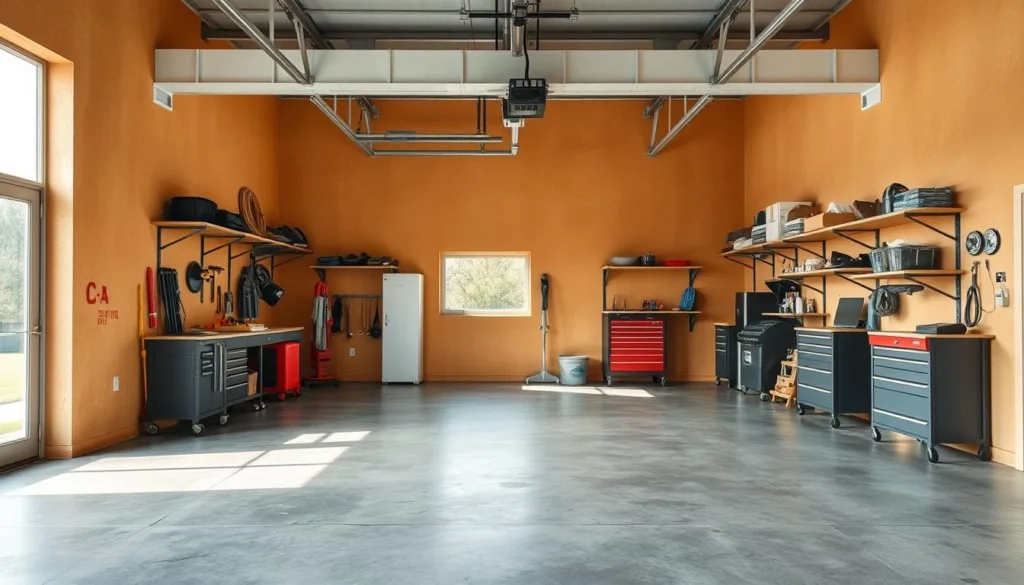
Lighter wall colors enhance natural light, making the space feel brighter. Pair them with the best paint for garage floors, such as epoxy or acrylic, for a cohesive look. Darker walls, on the other hand, hide dust but work best with light floors to prevent a closed-in feel.
Dunn-Edwards DURA paint offers 210 colors inspired by nature, perfect for DIY projects without priming. For high-traffic zones, Trusscore panels are a durable alternative to paint, resisting dents and moisture.
Oil-based paints provide excellent coverage but need careful handling. Water-based latex options, like Benjamin Moore Regal Select, dry faster and resist fading. Choose colors that complement your flooring, such as jewel tones or earthy greens with light hardwood floors.
Avoid matte finishes in workshops where tools or equipment might scratch the walls. Regular cleaning with mild cleaners helps maintain paint quality and extends its life. Always opt for paints with mildewcide additives to combat humidity in garages.
Modern Garage Color Trends in 2023
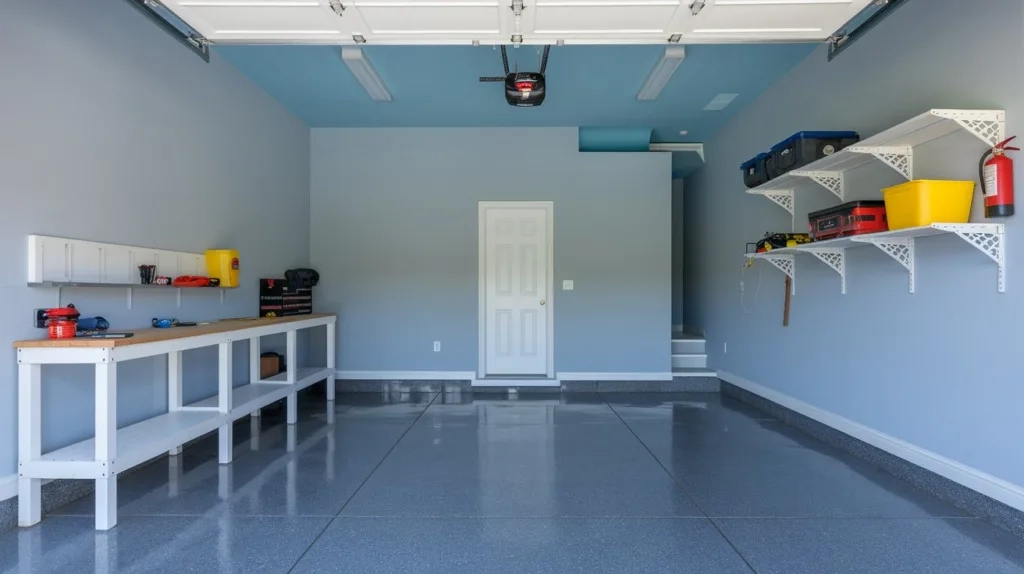
Natural neutrals lead the way in modern garage color trends this year. Homeowners are drawn to soft beiges, taupe, and greige for floors. These colors create a warm yet clean backdrop. Brands like Sherwin-Williams and Benjamin Moore offer perfect shades such as Alabaster and White Dove. These hues blend seamlessly with various décor styles.
Industrial styles are also gaining popularity. Concrete grays and slate blues add a sophisticated touch. These colors bring a modern edge to any garage.
Two-tone garage design ideas are trending, combining neutral floors with bold accent walls. Darker shades like Kendall Charcoal or Iron Ore complement wood tones in workshops. Automotive-inspired palettes, featuring navy and red accents, add a unique touch.
For multi-use spaces, softer shades like Cape Blue or Montana Agate strike a balance. They bring energy and calm together. This creates a harmonious environment.
Bold colors, such as Benjamin Moore’s Currant Red, energize workout areas. Epoxy floors in speckled grays hide dirt well, especially in snowy regions. Satin-finish paints from brands like Sherwin-Williams resist wear, making upkeep simpler. Pairing dark floors with light walls follows timeless design principles, avoiding dated looks.
Considerations for Different Garage Uses
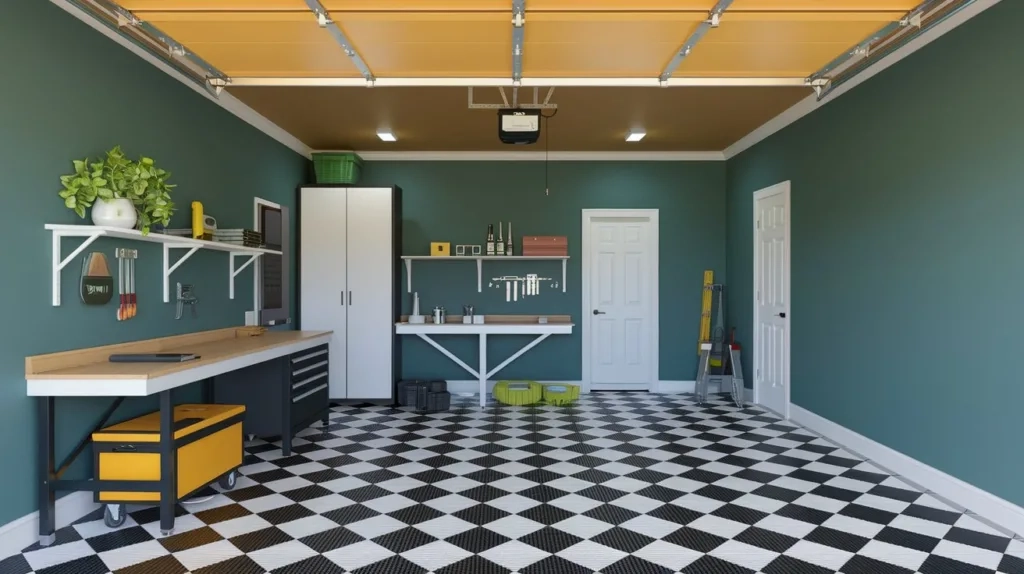
Garage design ideas must prioritize the space’s primary function. A workshop benefits from light walls that boost visibility during detailed tasks. Light grays or whites reflect more light, reducing eye strain while working with tools. Garage Living’s Floortex™ coatings, for instance, offer textured finishes that hide dust, making lighter shades practical even in high-traffic areas.
Storage-focused garages thrive with neutral tones like taupe or brown from UpCOUNTRY’s themes. These colors create a cohesive backdrop for organizational systems. Zone-based color coding—like bright accents on storage shelves—adds visual structure without overwhelming the space. A two-toned wall, such as sunny yellow paired with white, can blend functionality with garage makeover inspiration while keeping the area lively.
Car enthusiasts might opt for bold statements like deep blue walls with gold accents, inspired by classic racing themes. Harbor’s blue-and-gray palettes evoke a calming yet sophisticated vibe, perfect for showcasing vehicles. Colors should complement car hues; for example, a red car pairs well with charcoal walls to enhance contrast and elegance.
Multipurpose spaces need adaptable schemes. Warm grays or linen tones work for both hobbies and storage. Satin paint on walls resists stains better than flat finishes, maintaining cleanliness. Prioritizing function ensures the space remains both practical and stylish, whether it’s a workspace, gym, or hobby area.
Lighting and How It Affects Your Color Choices
Natural light significantly impacts color perception in your garage. North-facing areas receive cool, consistent light, enhancing dark hues and softening light tones. In contrast, south-facing garages are bathed in intense sunlight, brightening dark colors but potentially washing out whites. East and west orientations introduce morning golds and evening reds, constantly changing the color scheme throughout the day.
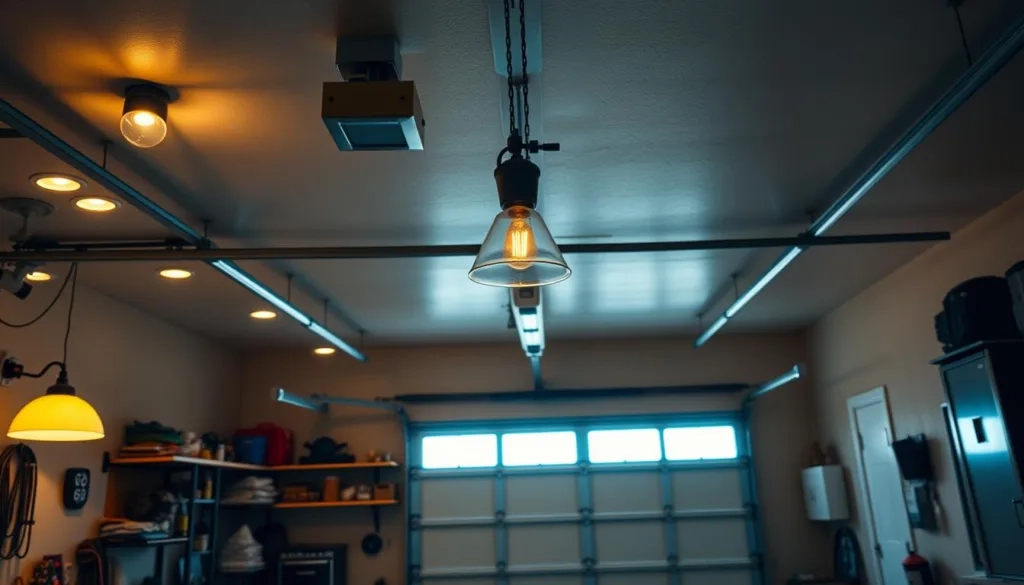
Artificial lighting, such as fluorescent bulbs, casts a blueish hue, ideal for cool color schemes. Incandescent bulbs, on the other hand, add warmth, enhancing reds and oranges. LEDs vary by Kelvin temperature, so it’s crucial to match bulbs to your garage design ideas through testing. Fluorescents at 5000K-5500K, commonly found in workshops, can clash with warmer paint choices unless carefully planned.
Light reflectance value (LRV) measures how much light a surface reflects. High-LRV colors brighten dim spaces. Test paint samples under different lighting conditions. Place swatches where you’ll paint and observe changes over 24 hours to ensure consistency with your chosen color schemes.
Bulb temperatures greatly influence the final appearance. Warm 2700K bulbs add an amber tone, ideal for cozy garage design ideas. Cooler 3500K bulbs are better suited for functional areas. High-CRI bulbs (above 80) show colors accurately. Use 2700K bulbs to reduce blue casts from north-facing windows or trees.
Match bulb types with wall and floor finishes. Avoid overly bright 5000K bulbs in spaces with dark woods. Test under all lighting conditions, including open and closed garage doors, to avoid surprises. This ensures your color choices work under every condition, creating a cohesive look in any garage design project.
DIY Tips for Painting Garage Floors and Walls
Before you start painting, test colors in your garage’s natural light. Apply small paint samples to a board and move them around the space. This will show you how hues change with daylight. Take photos at different times to avoid color surprises once fully painted. This ensures your garages with painted floors match your style.
Begin by cleaning concrete floors with a pressure washer, but avoid using it if old paint exists—it might peel more. For bare concrete, etch surfaces with acid to boost adhesion. Use an orbital sander with 80-grit paper to scuff existing floors lightly. Fill cracks and prime if needed. Walls require sanding and patching holes before priming.
Choose the best paint for garage floors like Behr Premium Concrete and Garage Paint, a 1-part epoxy that primes and seals in one step. Mix skid-resistant additives per the manufacturer’s ratio. Work when temperatures are 50–90°F for proper curing. Apply paint using rollers for floors and brushes for edges. Let each coat dry 1–4 hours before recoating.
After painting, allow 24 hours before walking on the floor and 72 hours for heavy use. Full cure takes 7 days before driving into the garage. Use semigloss paint on walls for easy cleaning. Avoid flat finishes, which trap dirt. Regularly inspect painted areas for wear, and touch up chips promptly to prevent rust or peeling.
Maintaining Your Garage’s Color Scheme Long-Term
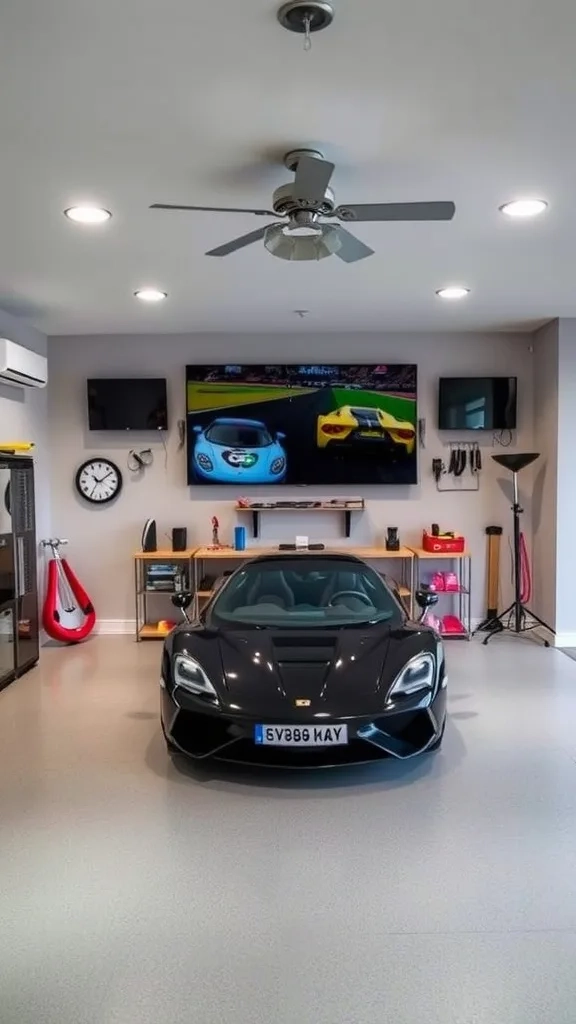
Regular upkeep is key to keeping garages with painted floors looking great. Clean epoxy or polyurea surfaces weekly with a mild detergent and a microfiber mop. Avoid using abrasive tools to prevent scratches. For walls, gently wipe down scuffs with a damp cloth and a non-abrasive cleaner. Semi-gloss paint on walls makes maintenance easier by resisting dirt buildup.
Seasonal checks are crucial. Inspect painted floors twice a year for cracks or fading. Colorado’s weather can cause color shifts, so monitor how walls and floors look against seasonal backdrops. Reapply a clear topcoat to epoxy floors every two years to restore shine. Touch up wall chips promptly using leftover paint to keep matching garage walls and floors cohesive.
Heavy traffic areas may need recoating more often. Epoxy coatings like Floortex™ in Pebble Beach Grey or Orbit resist wear better than standard paints. Store cleaning supplies near the garage entrance for easy access. Use pH-neutral cleaners to avoid damaging protective finishes.
Annual inspections catch issues early. Check garage door seams and wall corners for peeling paint. If floors show significant wear after five years, consider a full repaint. Budget-friendly updates like new wall decals or accent panels can refresh the look without full repainting.
Conclusion
Your garage can be more than a storage space—it’s an opportunity to blend style with practicality. Modern garage color trends focus on durability and aesthetics. Options like gray epoxy floors or earthy tones hide wear while maintaining curb appeal. When planning a garage makeover, start by aligning colors with your home’s exterior and daily use.
Neutral walls in white or beige pair well with vibrant floors like red or blue. This balance brings organization and energy to your space. Epoxy coatings, such as 1-part systems, offer lasting protection against stains and traffic. Jeff Schultz Painting, with over 35 years in the industry, emphasizes choosing paints based on function.
They recommend oil-based options for metal and mildewcide additives in humid areas. Gulf Coast clients often opt for semi-gloss finishes to hide fingerprints or slatwall panels for storage solutions. Lighting and ventilation are crucial. Test color choices under natural light and ensure proper airflow during painting.
Remember, darker floors like black epoxy resist dirt better than lighter shades. Vibrant blues boost workshop productivity. By combining these elements, your garage becomes a functional, inspiring space that complements your home’s design.
